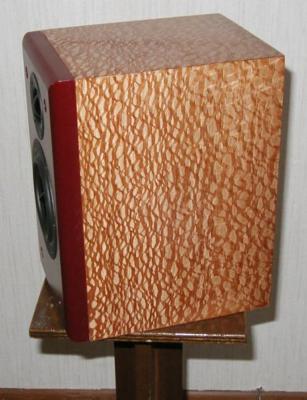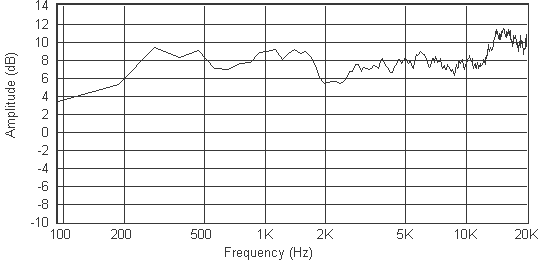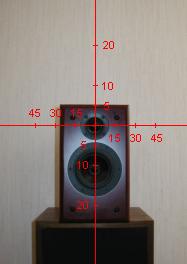
 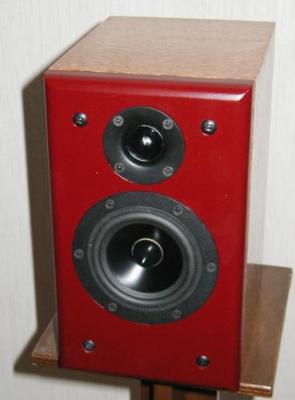
The RS125S-8 is no longer available but has been replaced by the RS125-8 (non-shielded) Substitution and performance data can be found at the bottom of the page... IntroductionThe Microbe is a tiny 2-way bookshelf speaker using the Dayton RS125S-8 5" inch aluminum coned woofer along with the Tangband T25-1166S 1" neodymium fabric dome tweeter. The Microbe is a relatively low-cost project that offers great performance in a small package. Despite its size it has decent bass response but a little bit of efficiency is sacrificed to get that deep bass response. They are magnetically shielded enough not to interfere with CRTs. A set of 5 or 7 of these would probably work great in a 5.1 or 7.1 surround sound setup.Alternate VersionDave Zachary wanted to build a design similar to the Microbe except he wanted to use the Dayton RS28as shielded aluminum dome tweeter instead of the Tang Band T25-1166S. He designed a cabinet that is similar to the original Microbe cabinet design except the woofer is moved down a bit to make room for the larger flange of the RS28as which is offset to one side. I used simulation tools to design a crossover for this combination and the results were good. This version has a slightly lower crossover point and a little bit better rejection of the RS125 resonance modes. The overall frequency response is a bit flatter and has less of a BBC dip in the upper midrange. The RS28as is probably a better tweeter than the T25-1166S but it also costs $30 more. The RS28a has a flatter overall response but rolls off a bit above 15kHz. The T25-1166S has better dispersion at high frequencies and has a bit more air and sparkle at the top end. I haven't heard the RS28as version but the original version is still hard to beat. However, this version has received high praise by those who have heard it so it must sound pretty good. The details for this project can be found in PDF format here.DriversTangband T25-1166S 1" neodymium fabric dome tweeter This compact neodymium tweeter offers very refined performance that is unusual for this size and price range. An enhanced dome damping technique gives excellent high frequency extension as well as good low-end response. With ferrofluid in the gap and a damped rear chamber, crossover design becomes much simpler. The small mounting flange is excellent for compact multimedia and home theater systems.Dayton RS125S-8 Reference Series 5" shielded aluminum woofer The Dayton Reference Series sets a new standard of value in high-performance loudspeaker drivers. Utilizing a low-distortion motor system with two short-circuit paths and a rigid aluminum cone, the Reference Series can outperform drivers that cost several times the price. Their low-distortion characteristics and high excursion capabilities provide exceptional clarity, detail, and dynamics. Woofers feature a shielded motor system, black anodized cone, heavy-duty 6-hole cast frame, low-loss rubber surround, and solid aluminum phase plug. Cabinet Design
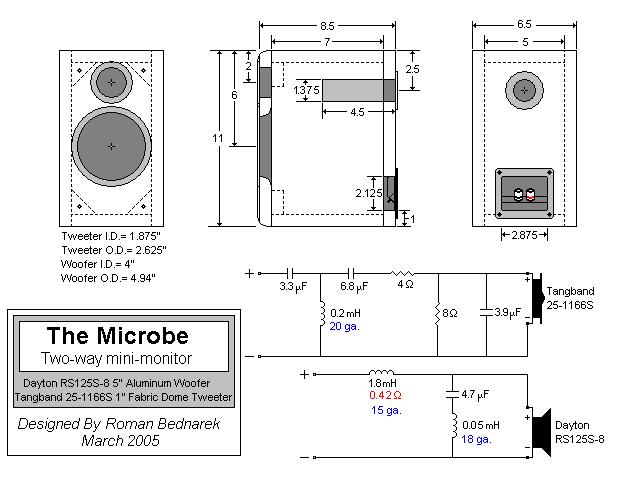
UPDATED CROSSOVER - See bottom of page Crossover DesignThe Microbe uses a 4th order Linkwitz Riley crossover with a crossover frequency of 3200 Hz. My goal was to keep the crossover as simple as possible so it would easily fit inside the cabinet and wouldn't cost a fortune in parts. Since the Dayton RS125 is an aluminum coned woofer it has the typical upper frequency resonances common to stiff coned drivers. There is a major resonance centered at 11.5 kHz and another minor resonance at 8 kHz. Instead of using two notch filters to independently filter out each resonance I made a compromise and used one notch filter centered between the two resonances that effectively attenuated both peaks enough that they should not be an issue. Another option would have been to use a sharper sloped filter but that would increase the complexity of the crossover and might make it more difficult to achieve proper phase alignment with the tweeter. The tweeter uses a standard 3rd order electrical high pass filter with an l-pad for attenuation. I added an extra capacitor in parallel with the tweeter to tame the peak in the tweeters response in the 15-20kHz region. Even with the capacitor the peak isn't removed entirely but it is in a region that fades off-axis and is also near the top limit of most people's hearing range so it isn't offensive. WIth these filters I was able to get very good phase alignment between the woofer and tweeter when listening on-axis with the tweeter. Below is a picture of the crossover layout. I was able to fit the crossover on a 4" x 4.75" board. I tried to keep the inductors isolated by placing them perpendicular to each other to minimize interference.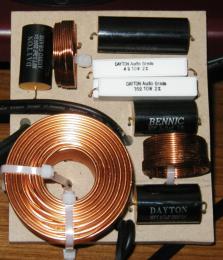
Performance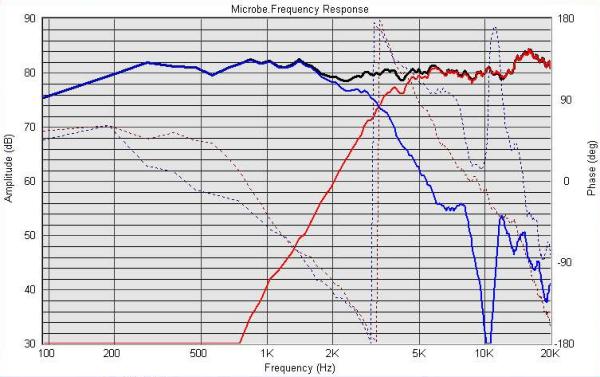
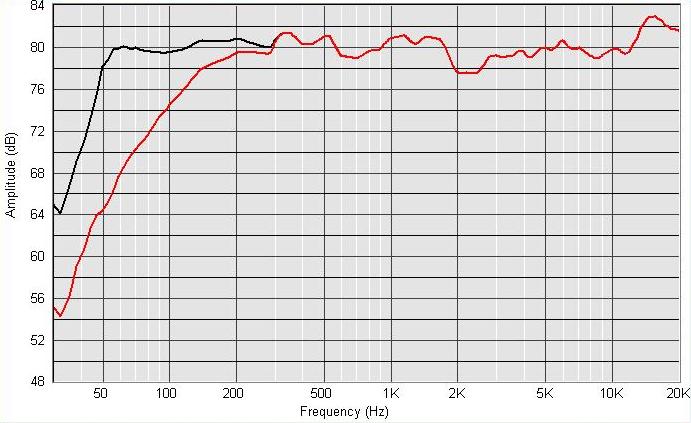 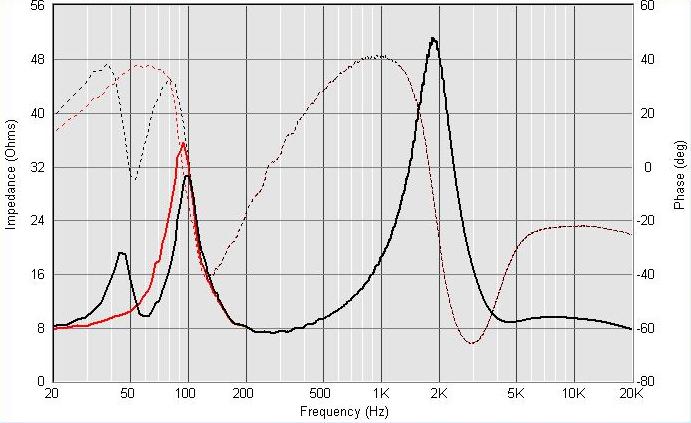
Below are plots of the off-axis response of the Microbe design measured at 1 meter at vertical angles of +/-5, 10 & 20 degrees and horizontal angles of +/-15, 30 & 45 degrees. Move your mouse over the speaker diagram to see the response at that angle.
The Microbes have a very clean, crisp and detailed sound to them. The Dayton RS125 provides a nice detailed midrange while still retaining some smoothness. Compared to some of my other designs the midrange is a bit forward with an emphasis in the mid to low midrange. Unlike some aluminum coned drivers the RS125's are not overly analytical but have a nice balance between detail and smoothness. Most aluminum coned drivers don't sound all that great with rock music and its distorted guitars but the Microbes are easy on your ears. The RS125 is certainly quite a bargain considering its price and great performance. Even in these little ported cabinets the bass is relatively deep considering their size. Simulations reveal them to have an f3 of 52 Hz but based on measurements they seem to be flat down to 50 Hz at which point they begin to roll off. Below 45 Hz the bass output drops significantly. They certainly sound a lot bigger than they look but the tradeoff is that they aren't super efficient. The Microbe's treble is very nice considering the price of the driver. The Tangband tweeters have a slight bit of a spitty sound at the extreme high end due to the peak in the response but if you listen slightly off axis they sound a bit better The treble is pretty balanced and there are no particular frequencies that jump out at you except for the extreme high end when you listen on-axis. At their price the Microbes are the best value of all of the designs in my projects section because they sound so good. If you want to make them fill out the entire spectrum then add a Cerberus subwoofer for about $100. Just plug the ports in the Microbes and the Cerberus sub fills in the bottom end very nicely. It has an f3 of 35 Hz and is a good match for the Microbes because it has slightly higher output capabilities and will increase the power handling of the Microbes in the bass region. There is a writeup on this combination under the Cerberus project section. Considering their price and size the Microbes are a bit of an overachiever. The total cost for a pair of Microbes including unfinished cabinets should be around $150 which isn't bad and certainly will beat anything available in the stores in that price range. Speaker Workshop Project FileThe Speaker Workshop project file for this design is now available for download: Microbe.swd. This project file includes gated and ungated farfield measurements for the drivers on axis with the tweeter (TA stands for "Tweeter Axis"). There's also a crossover network simulation based on measurements taken on axis with the tweeter. The file is about 1.5 MB so be patient if you have a slower connection.ReviewsI've gotten great comments about the Microbes from everybody who has heard them and I'm trying to build up a reviews section based on their impressions. My first reviewer is Jed Kunz who listened to the Microbes with the ports sealed along with the Cerberus subwoofer. Below is the review that he sent me.The Microbe speaker is a bargain loudspeaker because it does so many things well at a price that one might only get midfi at best. I couldn't believe the clarity that was produced by the little Dayton midrange/woofer, and the budget Tangband tweeter is an overachiever. This is one of those speakers that most HiFi shops would love to get their hands on because they could charge 10X what the parts cost. They sound that good! First, the treble is very smooth and detailed and the peak in the upper treble is not noticeable, especially if sitting off axis. I tried to play a few CDs that I thought would reveal peaks and dips in the frequency response, but the little Microbe speaker remained tonally balanced. Every little detail is not present with the Microbe if comparing it to some other expensive speakers, but the detail that it flushes out is pleasing to listen to and doesnít overemphasize itself. I think that concept is key in designing a budget speaker. The midrange was surprisingly on the warm side of the spectrum and this made listening to a variety of CDs with bright content more enjoyable. Since I listened to the Microbe with Romanís Tangband subwoofer, I really didnít get a chance to evaluate the Microbeís bass on its own. With the subwoofer turned on the bass was very tight, but I would prefer dual subwoofers for a better integrated sound and more impact. Though, that is up to each builder to decide because the bass with the Tangband subwoofer is surprisingly low for a small driver- below 35HZ! The Microbe excels at presenting a large percentange of the music in an engaging and non-offensive way. This characteristic is sometimes not found with inexpensive metal coned drivers. Roman B. has placed a lot of attention on getting the resonances attenuated below audibility. That is why the metal cone woofer sounds so smooth and lush in the Microbe design. One might think that a lower crossover point should have been used, but that just isnít the case with this combination of drivers. The midrange remains rich, and that is certainly true at realistic listening levels (below 95DB). Overall, I would have to say that the Microbes offer a lot for the money. They do not present the listener with the ultimate in uncolored midrange or the deepest and most articulate bass, but they never were intended for that. The Microbes are fun to listen to because it is hard to believe how much sound they actually reproduce, especially if using the dedicated Tangband subwoofer. The Microbe speaker does a good job disappearing and letting the listener do what they intended to do, and that is to listen to music! The Microbes are highly recommended and a bunch of them would make a great compact home theater setup. You really canít go wrong building a pair to try out for yourself. Jed Kunz The next review is from Bill Hurkman who built a pair of Microbes for his son as a Christmas present. He plans to build the Cerberus subwoofer sometime in the future. My goal was to build a small pair of good sounding, two-way speakers destined for my college sonís very small apartment. Of the relatively few DIY speaker designs with these criteria, I chose Roman Bednarekís Microbes. Granted, it is impossible to choose a speaker without first hearing it, so I based my decision on the information on his excellent website and his positive response to my questions about performance in my application. Without a doubt, the sound of the Microbes qualifies them as impressive small speakers. Since I built them for my son, who has an extensive collection of heavy metal music, I tested them first with rock music. The Microbes handled Rock You Like a Hurricane by the Scorpions, and Run to the Hills by Iron Maiden with aplomb. They brought out the heart beat in Pink Floydís Speak to Me and the bass intro in Styxís Renegade unexpectedly well. The bass is not wall shaking, but never-the-less pretty amazing considering the driver and box size. Female voices were extended and smooth with the Microbes, eg Enya (esp. Orinoco Flow), Loreena McKennitt (The Visit), and Holly Smith (Light from a Distant Shore). The rich sound of these recordings made it impossible for me to stop with just one selection from each of these artists. My son is a fan of flamenco music and the Microbes conveyed the excitement of Paco de Luciaís lightening style of play on Siroco. The real surprise was how well the Microbes performed playing classical music, my principle interest. The sound stage, image, depth, and clarity (airiness of the chorus, bass notes of the tympani, and fullness of the orchestra) were impressive for Handleís Hallelujah Chorus from the Messiah as well as the first movement of Beethovenís 5th Symphony. The emotion of Vaughan Williamsí Lark Ascending came across incredibly well. In summary, the Microbes are very musical speakers with bass that belies their small size. They put the voices and instruments in the room with you and it feels like you're listening more to music than just a pair of speakers. As Roman promised when I started this project, the Microbes are perfect for my application. Updated CrossoverIt had been brought to my attention that Parts Express now has a new model number listed for the Tang Band tweeter that is used in this project (T25-1166-SJ instead of T25-1166-S). The new set of specs seem to indicate that the newer version has a slightly lower sensitivity especially at the top and bottom ends of the tweeter's response. I was recently (mid June) sent a pair of these tweeters so that I could make the appropriate crossover adjustments. However, when I received the tweeters the model number printed on the tweeter and box indicated that they were the -S version. I was told by Mike V at Parts Express that they have had this stock for a little while and probably won't run out any time soon. Even though the model number indicates that they are the -S version measurements show that the response is indeed different than the original tweeters that I had been working with during my first few builds of that design. The new batch of tweeters have a lower sensitivity which coincides with the new specifications for the -SJ version. Regardless of whether the batch of tweeters that PE is currently selling is a different batch of -S tweeters or are actually -SJ tweeters with -S markings, crossover modifications were warranted to get the same response as before.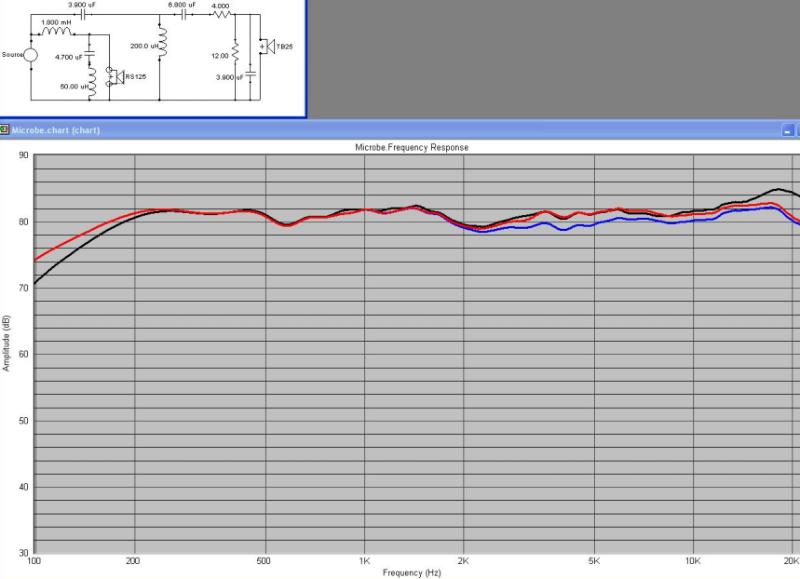
Above is the new crossover and response plots. The black trace is the response of the original Microbe design with my original batch of -S tweeters. The blue trace is the response of the original Microbe crossover with the new batch of tweeters. The red trace is the response of the modified Microbe crossover (shown) with the new batch of tweeters. If you find it difficult to read the schematic above, only two components have changed... the 3.3uF series tweeter capacitor is now 3.9uF and the 8 ohm parallel tweeter resistor is now 12 ohms (and a clearer updated schematic is now shown below). If you plan to build a set of Microbes with tweeters bought from Parts Express (which will most likely be from the same batch that I just tested) I would suggest that you use the new tweeter filter. If you have already built a pair of Microbes within the past few months then you may want to try the new filter just in case your set of tweeters is from that new batch. Another minor crossover modification I decided to make was the use of a 15 gauge Jantzen P-Core 1.8mH inductor in the woofer filter in place of the 15 gauge air core that I used for the prototype speaker. The reason that I made this change was due to the fact that copper prices have risen significantly since I first built this design and the 15 gauge air core inductors became a significant share of the total cost of the project. I've actually been in the habit of using "cored" inductors for larger values for quite some time now and despite what some people say about performance degradation due to saturation of the core (relative to air core inductors) I've concluded that most speakers don't reach power levels for this phenomenon to affect the performance or alter sound of the speaker. In the case of this design, the P-Core inductor has a slightly lower DCR than the original air core inductor which does change the frequency response slightly but only results in a miniscule boost of a fraction of a dB below 500 Hz. Since the P-Core inductor is shaped similar to an air core inductor, my original crossover component layout should still work fine with the P-Core inductor oriented exactly as the original 1.8 mH air core inductor was. At the time that this was written the cost savings for this "swap" was a reduction from about $20 per inductor to about $10 per inductor which is quite significant for a budget project like this. Below is an updated schematic which includes the crossover modifications for the tweeter as well as the inductor. 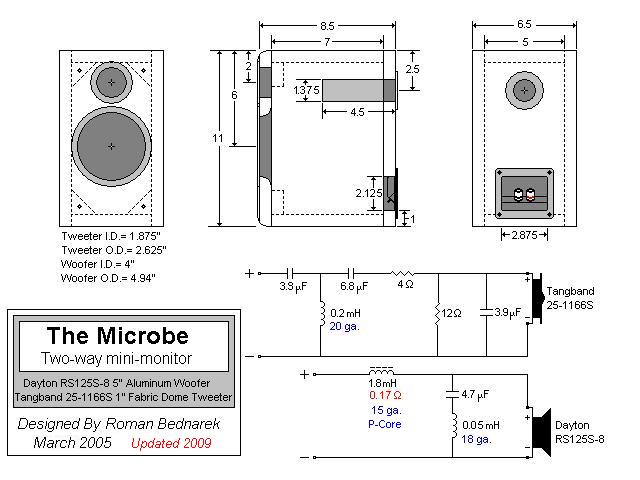
Using the new RS125-8 woofer in place of the discontinued RS125S-8A while back it had been brought to my attention that the RS125S-8 woofer was no longer available from Parts Express. It seems that they replaced it with a non-shielded version, the RS125-8. Since then I've received a few other emails from people who have run into the same situation. Even though I did most of the analysis when I first found out about this issue, I apologize for not including my analysis on this page for others who are concerned about this issue (and I'm sorry to those who had emailed me regarding this issue that I hadn't gotten back to). However, I'm happy to say that the simulation analysis has been completed and overall it looks like the new RS125-8 woofer will work fine as a direct, drop-in, substitution without any crossover or cabinet modifications at all. I'm sure that there will be a slight change in the overall sound of the speaker with the substitution but the simulation seems to indicate that the new woofer might even be an improvement over the original woofer and I'll discuss why below.I ran two basic simulations in order to determine what might change between the old and the new woofer. The first simulation was done using Unibox in order to see how the bass response might change between the two different woofers based upon a slight change in the T/S parameters. I assumed the same enclosure for both simulations and estimated the original Microbe cabinet to be about 5.5L in volume with a port tuning of around 57Hz. Below is a plot of the results for both woofers... 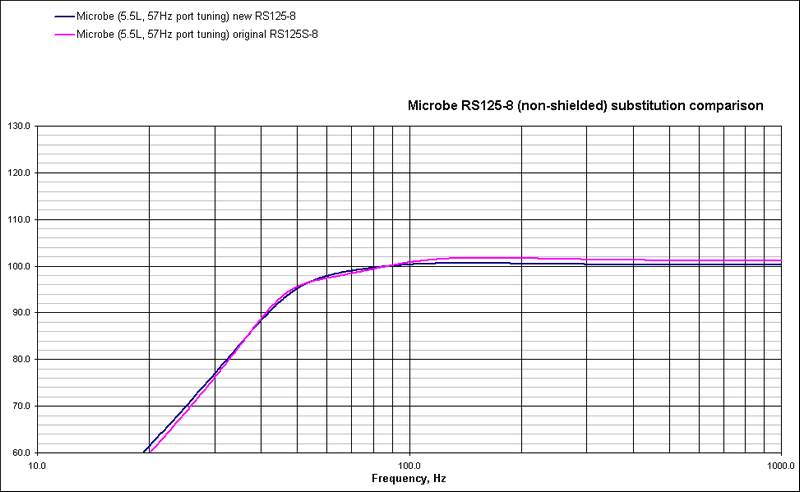
As you can see in the plot above, the original RS125S-8 woofer exhibits more of an EBS (Extended Bass Shelf) frequency response which typically is an indication that either the enclosure was chosen to be a bit larger than what the woofer would normally require and/or the port tuning was intentionally pushed lower than typical. In this case it is the port tuning which was dropped a bit lower in order to extend the bass response and improve the power handling near the port tuning frequency. This is part of the reason why the original Microbe seemed to have a lot of bass for such a small speaker. However, if you look at the frequency response for the RS125-8, when used in the same enclosure with the same port tuning, you'll notice that the bass extension seems a bit more natural with a bit less of a peak above 100 Hz and a smoother roll-off below that point with slightly more bass output in that region. So based on the simulation shown above, the new RS125-8 woofer seems to be an improvement over the original RS125S-8 woofer that I based the Microbe cabinet design around. It is quite fortunate that the cabinet ended up working better with the RS125-8 than the RS125S-8 based on the simulation but considering that I haven't heard the two different designs side-by-side (I've only simulated them) I can't really say what the "subjective" difference in sound might be... only that the odds are that there will be an improvement in sound quality in the bass region. Now that I've simulated and shown that the new woofer will work great in the original Microbe cabinet, I decided to run a Speaker Workshop simulation in order to compare possible differences in frequency response. The most logical method that I could think of was to basically consider the differences in frequency response between the two woofers based on the frequency response data that I had from the Parts Express website for the original RS125S-8 woofer and the new RS125-8 woofer (considering that their measurements should be a good baseline in representing the average performance for each batch of woofers). Once I determined the differences in frequency response between the two woofers, I simply used the difference to alter the frequency response in my orignal Microbe simulation. With all of that said, below is a plot of the original Microbe frequency response along with a plot of the overall frequency response based on the response differences between the RS125S-8 and the RS125-8 (note that this comparison doesn't take into account any differences in _impedance_ responses between the two woofers but I was able to estimate that any differences were so minor that they would have very little effect on the overall performance of the drivers and crossover.) The green trace in the plot above represents the new frequency response of the Microbe speaker design using the RS125-8 woofer substitution as compared to the previous frequency response based on the original RS125S-8. This simulation may not represent some of the tweeter/crossover modifications documented above, but still offers a very good representaion of how the frequency response and sound might change with the new RS125-8 woofer. Surprisingly, once again, the new woofer actually seems to perform better than the old one considering that it is a bit stronger in regions where the response dipped and is slightly attenuated in regions where there was initially a response peak. So based on this simulation and my knowledge of the sound quality of the original Microbe design (also based upon my listening impressions above), I would have to say that the new RS125-8 woofer should provide a more neutral sound overall relative to my original design. Once again it seems like the RS125-8 should be an improvement without any additional crossover modifications. With all of that said, the simulations all indicate that the RS125-8 should work remarkably well in the original design. I see no reason why the RS125-8 woofer won't work with the existing Microbe design and in fact it should actually sound better than the original based on the data collected. However, I haven't built a pair of Microbes using the new woofer so I will have to rely on the ears and opinions of those who plan to build the Microbes using the new non-shielded RS125-8. If you do plan to build a pair, it would be greatly appreciated if you could tell me how they sound using the new woofers (even if you hadn't heard them before with the original woofers). This will help give me a better idea regarding the woofer substitution and hopefully increase my confidence to give the okay for others to build this design if things work out well. Hopefully the results will be good and others can have confidence in the woofer substitution. Even though I've been focusing on other endeavors lately, I'm still tempted to know what the "latest" version of the Microbes might sound like compared to the original pair that I built. Personally I'm very happy that the new woofer seems like it will work well in the existing design because these little Microbes have made quite a few audiophile's and DIY enthusiast's ears very happy! That's probably the biggest reward for a speaker designer like myself in that the small amount of design work that it took to make the original "prototype" Microbes can be shared with the dozens of people who have built them. I take pride in helping others enjoy their favorite music just a bit more through a nice sounding set of speakers that are affordable. Thank you to all who have built, shared, and enjoy my speaker designs! |
